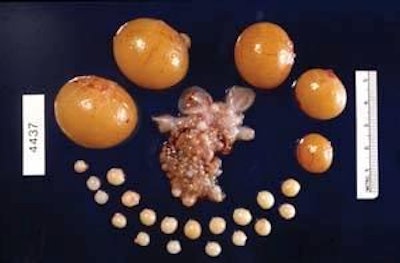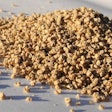
The International Symposium on Avian Endocrinology, held in Leuven, Belgium, last year, detailed new findings on how hormones control egg production, shell formation, reproductive responsiveness to light, gut function and energy balance.
Growth of ovarian follicles
High persistency of egg production depends on well-ordered hierarchies of yolky follicles in the hens' ovaries. A novel protein, called Id2, has been discovered in undeveloped follicles about to enter the follicular hierarchy.
Dr Al Johnson of the University of Notre Dame, US, reported how this protein makes the newly selected follicle responsive to the high levels of follicle stimulating hormone present in the blood of laying hens.
The subsequent growth of newly selected ovarian follicles depends on the uptake of yolk precursors made in the liver. These have to pass from the blood through several layers of tissues in the wall of the follicle and membranes surrounding the ovum. Exactly how the yolk precursors pass through these layers has been a mystery.
Now, however, Professor Wolfgang Schneider of the Medical University of Vienna, Austria, may have solved this enigma. He reported that the identification of three specialised proteins in these layers of tissue that cooperate to transfer yolk precursor into the growing follicle has been made.
Shell gland signals for calcium from bone
Good egg shells throughout the laying cycle are essential for profitability. Egg shell formation in the shell gland depends on the production of many specialised proteins.
Dr Ian Dunn of the Roslin Institute, University of Edinburgh, UK, reported that there are up to 300 genes coding these proteins. One of these genes codes for a hormone called osteoprotegrin. It looks highly probable that this hormone is secreted from the shell gland into the blood to mobilise calcium from bone for egg shell formation.
How light stimulates egg laying
Increased lighting is a key management tool to synchronise the onset of lay and maximise egg production, yet it is not fully understood how increased lighting has this effect.
A team led by Professor Takashi Yoshimura of the University of Nagoya, Japan, has now uncovered the mechanism involved.
Professor Yoshimura's team has discovered a specialised layer of cells on the base of the brain, anatomically known as the pars tuberalis, that responds rapidly to increased lighting.
After photostimulation, pars tuberalis cells start to produce a thyroid stimulating hormone. Usually, this hormone is secreted from the pituitary gland to maintain the thyroids but when produced in the pars tuberalis,the thyroid stimulating hormone is taken up directly into the brain. Here, it stimulates, indirectly, the release of a brain neuropeptide, gonadotrophin releasing hormone, that triggers the releaseof pituitary hormones - controlling reproduction and egg laying - into the blood.
New insights into gut hormones
The gut produces hormones that regulate appetite and energy balance. A hormone recently discovered in the gut of mammals, ghrelin, is the only gut hormone known to stimulate appetite. Dr Hiro Kiaya, of the National Cardiovascular Center Research Institute, Japan, reported that the chicken gut also produces and secretes ghrelin. Surprisingly, unlike mammals, high concentrations of ghrelin in chicken blood do not have any effect on appetite. However, if ghrelin is injected directly into the chicken's brain, it inhibits food intake in contrast to its stimulatory effect in mammals.
The pharmaceutical industry is already developing drugs based on ghrelin biology to control appetite. However, it cannot be assumed that any drug developed to control appetite in man will be equally useful in broiler breeders.
Glocagon stimulates production
Energy balance depends on the regulation of glucose concentrations in the blood by glucagon and insulin.
Dr Mark Richards of Beltsville, US, described how glucagon is synthesised and showed that its receptor is most abundant in abdominal fat and liver. Dr Richards also showed that glucagon production is associated with the synthesis of two closely related peptides, whose function in the gut remains to be discovered.
Insulin promotes the uptake of glucose into tissues. The complexities of the pathways used by insulin in different tissues was reported by Dr Joelle Dupont of INRA, France.
The liver is a major target for the actions of insulin in poultry and mammals. In contrast to mammals, chicken muscle is very insensitive to insulin, making it a model of insulin resistance of medical interest.


